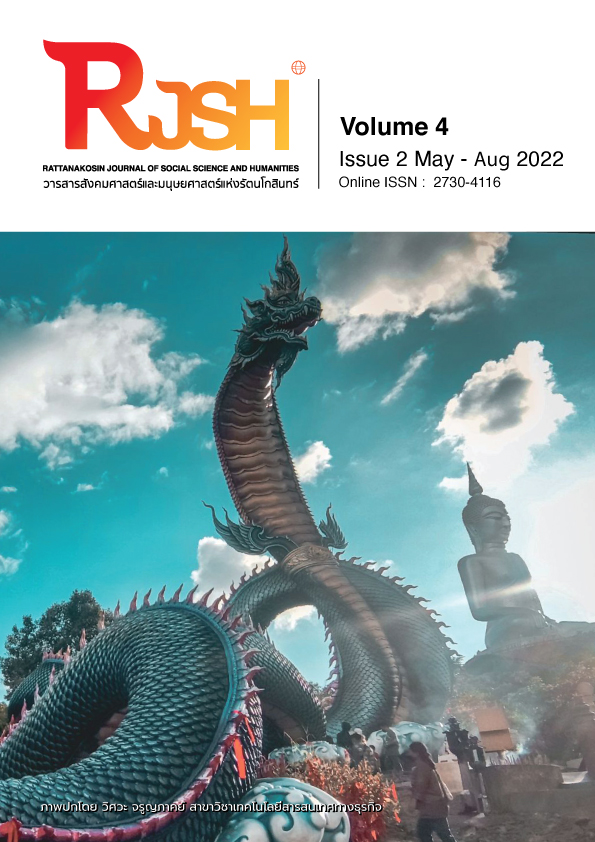The Development 3D Computer Animation to Promote Health Care on Nutrition of School-aged Children
Main Article Content
Abstract
The purposes of this research are: 1) to design and develop 3D animation to promote health care on the nutrition of school-age children and 2) to assess the performance of 3D animation media. The population used in the research is 500 students from elementary and middle school students of Bansomdejchaopraya Rajabhat University. The sample in this study is from the accidental sampling method and the number of sample students is 30. The research tools are: 1) the animation media to promote health care on the nutrition of school-aged children. 2) the questionnaires of expert opinions analyzed for consistency of animation media design. 3) the animation performance evaluation form for experts on contents and designs of animation media and 4) the satisfaction evaluation form for animation media. The statistics used for data analysis are mean, and standard deviation. The results of the research showed that the 3D animation production was 3.56 minutes long. The evaluation results were as follows. The animation media design and performance evaluation results were appropriate. The evaluation results were at a good level and the satisfaction was also at a good level.
Article Details
The content within the published articles, including images and tables, is copyrighted by Rajamangala University of Technology Rattanakosin. Any use of the article's content, text, ideas, images, or tables for commercial purposes in various formats requires permission from the journal's editorial board.
Rajamangala University of Technology Rattanakosin permits the use and dissemination of article files under the condition that proper attribution to the journal is provided and the content is not used for commercial purposes.
The opinions and views expressed in the articles are solely those of the respective authors and are not associated with Rajamangala University of Technology Rattanakosin or other faculty members in the university. The authors bear full responsibility for the content of their articles, including any errors, and are responsible for the content and editorial review. The editorial board is not responsible for the content or views expressed in the articles.
References
จรูญพร ปรปักษ์ประลัย. (2548). Animation says Hi! สวัสดี แอนิเมชัน. พิมพ์ครั้งที่ 1. กรุงเทพฯ: โรงพิมพ์กรุงเทพ.
ณัฐวุฒิ อยู่สุข, พิศประไพ สาระศาลิน, และชัยยพร พานิชรุทติวงศ์. (2560). การศึกษาการเคลื่อนไหวการแสดงอารมณ์ในงานแอนิเมชัน 3 มิติ แนวตลกขบขันกรณีศึกษาพฤติกรรมการติดโทรศัพท์มือถือ. การประชุมวิชาการระดับชาติ มหาวิทยาลัยรังสิต ประจำปี พ.ศ 2560 (หน้า 536-545). ปทุมธานี: มหาวิทยาลัยรังสิต.
ประคอง กรรณสูต. (2538). สถิติเพื่อการวิจัยทางพฤติกรรมศาสตร์. พิมพ์ครั้งที่ 2. กรุงเทพฯ: โรงพิมพ์แห่งจุฬาลงกรณ์มหาวิทยาลัย.
ปรียนันท์ หล่อเภรี. (2557). พฤติกรรมการบริโภคอาหารของนักเรียนประถมศึกษาตอนปลาย. สืบค้นเมื่อ 20 พฤษภาคม 2564 จาก http://arcbs.bsru.ac.th/journal/File63621. pdf?fbclid=IwAR1s1nufcpqn 3WF7fonZ_X.
วิชชุตา มัคสิงห์,นอลีสา โต๊ะยุโส๊ะ, และ จิรกานต์ พันธ์ฤทธิ์ดำ. (2559). ปัจจัยที่มีความสัมพันธ์กับพฤติกรรมการดูแลสุขภาพของเด็กวัยเรียน. วารสารเครือข่ายวิทยาลัยพยาบาลและการสาธารณสุขภาคใต้ วิทยาลัยพยาบาลบรมราชชนนี ประจำปี 2559 (หน้า 65-76). สงขลา: วิทยาลัยพยาบาลบรมราชชนนี.
สุวิช ถิระโคตร และ ชญา หิรัญเจริญเวช. (2561). ปัจจัยที่มีอิทธิพลต่อการใช้แอนิเมชันเพื่อการเรียนรู้ของนักเรียนนักศึกษา. วารสารวิชาการนวัตกรรมสื่อสารสังคม วิทยาลัยนวัตกรรมสื่อสารสังคม มหาวิทยาลัยศรีนครินทรวิโรฒ ปีประจำปี พ.ศ 2560 (หน้า 32-39). กรุงเทพฯ: มหาวิทยาลัยศรีนครินทรวิโรฒ.
อภิญญา อุตระชัย และ กริช เรืองไชย. (2561). ความสัมพันธ์ระหว่างความรู้ พฤติกรรมการบริโภคขนมและเครื่องดื่มรสหวานและภาวะโภชนาการของในนักเรียนชั้นมัธยมศึกษาตอนต้น อำเภอเมือง จังหวัดราชบุรี. วารสารมหาวิทยาลัยนครพนม ฉบับการประชุมวิชาการครบรอบ 25 ปี วิทยาลัยพยาบาลบรมราชชนนีนครพนม มหาวิทยาลัยนครพนม ประจำปี พ.ศ 2561 (หน้า 95-102). นครพนม: มหาวิทยาลัยนครพนม.
Tsukamoto, H. (2004). Manga matrix: create unique characters using the Japanese matrix system. China: Everbest Printing Co., Ltd.


